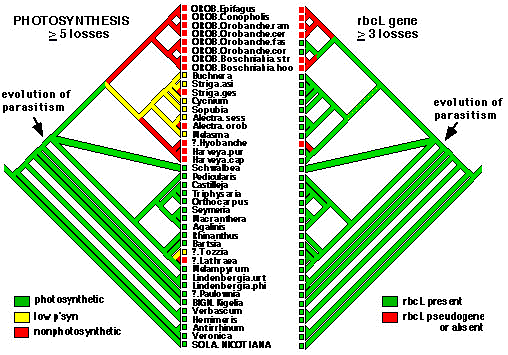

In this case, parasites are a monophyletic group, but other characters (loss of chlorophyll and particular chlorophyll genes) have happened multiple times.
There's a lot of work done with phylogenies comparing the relative (inferred) times of evolution of different characters. We won't go over details of how one constructs phylogenetic trees, but it is very important to get the details right: otherwise one risks drawing false conclusions (see K. Rohde, "Robust phylogenies and adaptive radiations: a critical examination of methods used to identify key innovations", American Naturalist 148: 481-500). There is another very good recent paper on parasite phylogenies by Tom Whittam's lab (reference for UF students, with password, here), although this paper will be more useful when we get to talking about the evolution of virulence.
The good news: In some ways, you are in a beautiful, warm, predictable environment. Imagine yourself sitting on the beach with food washing up on the tide, all you have to do is pick it up ... the host takes care of homeostasis (after all, it needs to regulate a constant environment for the sake of its own internal function) and goes to the effort of foraging and processing food for you.
The bad news: At the same time, it's in the host's interest to get rid of you. Unless you can minimize your impact (which may mean getting less food for yourself) or find some way to contribute to the "internal ecology" of the host (which essentially means turning into a mutualist), the host is going to spend all of its time evolving nasty tricks to kill you or convince you to leave. The energy that hosts spend on defense against parasites can be huge, because the alternative is allowing a continuing drain on resources.
In addition, the host you're in won't last forever, and at some point you have to figure out a way of getting yourself (or more typically your offspring) into another host. From this point of view, we have the paradigm (closely mirrored in ecology these days, where many researchers are interested in habitats that are naturally or artificially patchy, and so present non-parasites with the same difficulty of how to spread oneself or one's offspring between patches (metapopulation biology; we will also look at the comparison, on a longer time scale, with island biogeography). We will see later that there are many parallels, e.g. the trade-off between allocating resources to competition within a patch or to dispersal between patches. However, the big difference between parasites and non-parasites is that in parasite biology the "patches" are living, coevolving, and actively hostile.
Q?
In more detail, let's look at Barnard's categories under The Cost of Scroungers. Before we do, though, let's get straight the definition of fitness: the fitness of an organism is (measured by) the number of offspring it is able to produce in the next generation. More technically, from a gene-centered point of view, the fitness of a gene (in a given environmental and genetic background) is the number of copies of itself it manages to produce in the next generation. Individual fitness varies with the environment an individual finds itself in (population density of conspecifics and competitors/parasites/predators/prey, as well as the abiotic environment); fitness of a gene varies with the environment it is in, which includes both the ecological details just mentioned and the genetic background--what other genes it is sharing its organism wtih.
Growth, survivorship, and fecundity are indirect measurements (often used by ecologists) of fitness, but not fitness itself.
Now back to the cost of scroungers:
Barnard also cites examples where "scroungers ... force metabolic investment more directly" -- apparently changing host allocation, growth schedules, etc. (many parasitized animals (mice, rats, ants, snails, Tribolium (flour beetles)) grow much larger than their unparasitized counterparts, sometimes foregoing reproduction as well. In some of these cases there are clear physiological mechanisms (e.g. secretion of growth factors by the parasites) that indicate parasite manipulation, in other cases it just seems that the changes couldn't possibly be compensation by the host. Trying to distinguish host compensation from changes that the parasite induces "on purpose" to increase its own fitness is another big can of worms that we will get into later.